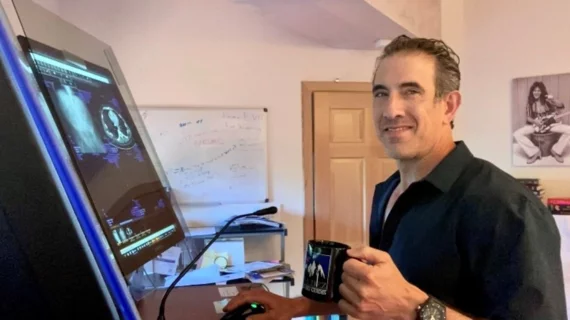Can you recall the last shift during which you spent close to 100% of your time on clinical duties?
I can. It was my last shift. I had no administrative obligations, no committee meetings, no software glitches, no running around trying to find a physician or tech—just eyes on images and voice into the mic.
Then again, every shift is like that for me. After working in several private practices, I’ve spent the last 11 years doing full-time teleradiology—backed 24/7 by a superb support team of 51 dedicated staff.
I’m blogging today to tell you that this has an incredible impact on your efficiency and productivity.
Let me give you some examples of life with and without a powerful support team like the vRad Operations Center (OC).
Time-wasting issues I no longer encounter. Do any of these sound familiar?
- Getting bounced around an automated phone system trying to call a clinician or technologist.
- Scrambling to find referrers who are on the move and sometimes off duty.
- Tracking down prior reports, images, and clinical histories.
- Faxing a report or finding someone to do it for me.
- Wishing I had a peer to consult for a complex case.
- Finding a colleague to cover for a day off, a schedule change, or simply a dinner break.
Contrast this with the 24/7 support I get at vRad.
I can request immediate help for all the above and more simply by clicking a button right in the study I’m reading. A window appears; I select the appropriate option for whatever support I need—Request Prior Reports or Images, Reassign a Case, Speak with Ordering Physician, Request Missing History and so on. Our OC team snaps to action behind the scenes while I continue reading cases.
And those are just the administrative assists. The same goes for technical support. The IT people here are fantastic. Any time of day, I can instant-message our IT staff who are on shift live within the OC. They can talk us through fixes or remotely log into our workstations to solve glitches that may arise.
A lot more support happens in the background here like licensing, credentialing and CME tracking. But more on that in another blog.
Our support staff are the prime factor in my job satisfaction.
Exactly what I signed up for when I selected my specialty
The reason this level of support is so important to me is simple. I like to read cases.
For more than a decade now I’ve been able to practice pure radiology—unadulterated medicine.
In fact, when I switched to 100% teleradiology with vRad, I was surprised by how many more cases I was able to read without sacrificing accuracy. To that point, it’s worth noting that we have neither minimum nor maximum reading rates. This means you—the radiologist—have the authority to control your own pace. Above all, vRad wants quality reads (and they have an extensive QA program to ensure this).
Your comfortable level of productivity determines your compensation. (You can read more about vRad compensation in a blog post by vRad CMO Dr. Benjamin Strong, Radiologist Salary Reckoning: Who Has Control Over Your Compensation?)
I love to be active outdoors whenever possible, which comes naturally to the small, vibrant community I call home. I am a skiing fanatic—which also comes naturally to Lake Tahoe—and also enjoy mountain biking, SUPing, staying in shape and living a simple life with my family and sons.
The joy of arriving and staying put
Over the past 11 years, I’ve had many job offers from former practices and recruiters. But I have chosen to stay with vRad.
In terms of work-life balance and overall fulfillment, I can’t imagine a better scenario.
I grew up and trained in the Northeast but chose Lake Tahoe for my home and workplace, residing in a favorite vacation spot. I ski in winter, paddleboard and mountain bike in summer, and more.
I’m right where I want to be—in more ways than one.
Jim Sloves, MD, has been a vRad radiologist since 2010. Dr. Sloves completed a cross sectional imaging fellowship at Johns Hopkins University and his residency at North Shore University Hospital.
